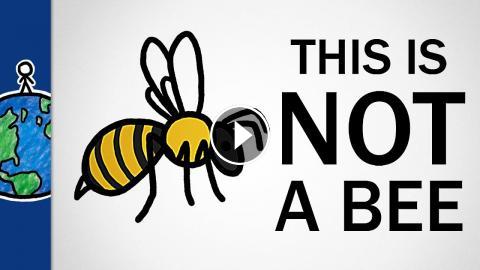Thanks to Dollar Shave Club for sponsoring this video. Get your first month of the Executive Razor with Dr. Carver’s Shave Butter for only $5 at
It can be hard to distinguish bees from all the other insects out there that look like bees.
Thanks also to our supporters on
___________________________________________
If you want to learn more about this topic, start your googling here:
Mullerian mimicry: a type of mimicry in which two or more animals with defenses develop similar appearances as a shared protective device
Batesian mimicry: a type of mimicry in which an animal with no defenses is protected by its resemblance to an animal capable of defense
___________________________________________
Credits (and Twitter handles):
Script Writer: Kate Yoshida (@KateYoshida)
Script Editor: Alex Reich (@alexhreich)
Video Illustrator: Ever Salazar (@eversalazar)
Video Director: Kate Yoshida (@KateYoshida)
Video Narrator: Kate Yoshida (@KateYoshida)
With Contributions From: Henry Reich, Emily Elert, Peter Reich, David Goldenberg
Music by: Nathaniel Schroeder:
_________________________________________
Like our videos?
Subscribe to MinuteEarth on YouTube:
Support us on Patreon:
Also, say hello on:
Facebook:
Twitter:
And find us on itunes:
___________________________________________
If you liked this week’s video, we think you might also like:
A collection of "bees" that aren't bees:
___________________________________________
References:
Brower J.V.Z. & Brower L.P., (1965). Experimental studies of mimicry. 8. Further investigations of honeybees (Apis mellifera) and their dronefly mimics (Eristalis spp.). American Naturalist 99:173–187.
Dyer, F., Jan 2017, personal communication.
Franks, D. W. and Noble, J., (2002). The origins of mimicry rings. Standish, R. K., Bedau, M. A. and Abbass, H. A.(eds.) In Artificial Life VIII: Proceedings of the Eighth International Conference on Artificial Life. MIT Press., pp. 186-191.
Pasteur, G., (1982). A classificatory review of mimicry systems. Annual Review of Ecology & Systematics, 13: 169–199.
Rettenmeyer, C.W., (1970). Insect Mimicry. Annual Review of Entomology 15: 43-74. .
Wilson, J., Jan 2017, personal communication.
___________________________________________
Image Credits:
Honey bee (Apis mellifera) - Charles James Sharp
.jpg
Sugar bag bee - Graham Wise
.jpg
Agapostemon virescens - Susan Ellis
Amegilla cingulata bee - Chiswick Chap
Drone fly (Eristalis tenax) - Francis C. Franklin
Eumeninae Wasp - Joaquim Alves Gaspar
Sesia apiformis - Gyorgy Csoka
Lunate Blister Beetle - Bernard DUPONT
Plain Lacewing (Cethosia hypsea) caterpillar - Bernard Dupont
Nymph of Green Milkweed Locust (Phymateus viridipes) - Bernard DUPONT
_(13983971884).jpg
Eristalis tenax - Wilder Kaiser
Yellow Jacket Wasp - Wikimedia user Bombman356
It can be hard to distinguish bees from all the other insects out there that look like bees.
Thanks also to our supporters on
___________________________________________
If you want to learn more about this topic, start your googling here:
Mullerian mimicry: a type of mimicry in which two or more animals with defenses develop similar appearances as a shared protective device
Batesian mimicry: a type of mimicry in which an animal with no defenses is protected by its resemblance to an animal capable of defense
___________________________________________
Credits (and Twitter handles):
Script Writer: Kate Yoshida (@KateYoshida)
Script Editor: Alex Reich (@alexhreich)
Video Illustrator: Ever Salazar (@eversalazar)
Video Director: Kate Yoshida (@KateYoshida)
Video Narrator: Kate Yoshida (@KateYoshida)
With Contributions From: Henry Reich, Emily Elert, Peter Reich, David Goldenberg
Music by: Nathaniel Schroeder:
_________________________________________
Like our videos?
Subscribe to MinuteEarth on YouTube:
Support us on Patreon:
Also, say hello on:
Facebook:
Twitter:
And find us on itunes:
___________________________________________
If you liked this week’s video, we think you might also like:
A collection of "bees" that aren't bees:
___________________________________________
References:
Brower J.V.Z. & Brower L.P., (1965). Experimental studies of mimicry. 8. Further investigations of honeybees (Apis mellifera) and their dronefly mimics (Eristalis spp.). American Naturalist 99:173–187.
Dyer, F., Jan 2017, personal communication.
Franks, D. W. and Noble, J., (2002). The origins of mimicry rings. Standish, R. K., Bedau, M. A. and Abbass, H. A.(eds.) In Artificial Life VIII: Proceedings of the Eighth International Conference on Artificial Life. MIT Press., pp. 186-191.
Pasteur, G., (1982). A classificatory review of mimicry systems. Annual Review of Ecology & Systematics, 13: 169–199.
Rettenmeyer, C.W., (1970). Insect Mimicry. Annual Review of Entomology 15: 43-74. .
Wilson, J., Jan 2017, personal communication.
___________________________________________
Image Credits:
Honey bee (Apis mellifera) - Charles James Sharp
.jpg
Sugar bag bee - Graham Wise
.jpg
Agapostemon virescens - Susan Ellis
Amegilla cingulata bee - Chiswick Chap
Drone fly (Eristalis tenax) - Francis C. Franklin
Eumeninae Wasp - Joaquim Alves Gaspar
Sesia apiformis - Gyorgy Csoka
Lunate Blister Beetle - Bernard DUPONT
Plain Lacewing (Cethosia hypsea) caterpillar - Bernard Dupont
Nymph of Green Milkweed Locust (Phymateus viridipes) - Bernard DUPONT
_(13983971884).jpg
Eristalis tenax - Wilder Kaiser
Yellow Jacket Wasp - Wikimedia user Bombman356
- Category
- Success
Sign in or sign up to post comments.
Be the first to comment






